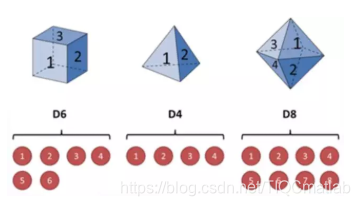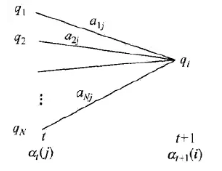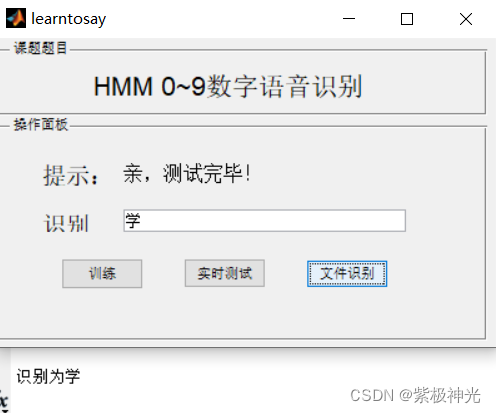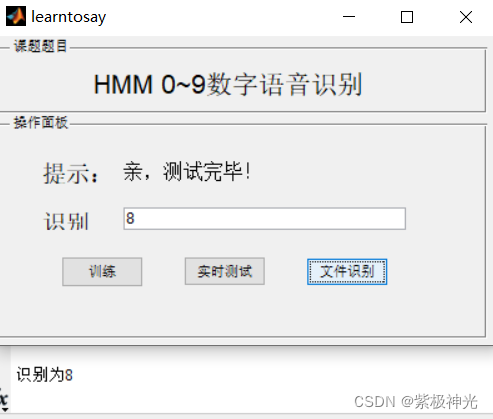【语音识别】基于matlab GUI HMM 0~9数字和汉字语音识别(带面板)【含Matlab源码 1716期】
一、隐马尔可夫模型简介
隐马尔可夫模型(Hidden Markov model, HMM)是一种结构最简单的动态贝叶斯网的生成模型,它也是一种著名的有向图模型。它是典型的自然语言中处理标注问题的统计机器学模型,本文将重点介绍这种经典的机器学习模型。
1 引言
假设有三个不同的骰子(6面、4面、8面),每次先从三个骰子里面选择一个,每个骰子选中的概率为1/3,如下图所示,重复上述过程,得到一串数值[1,6,3,5,2,7]。这些可观测变量组成可观测状态链。同时,在隐马尔可夫模型中还有一条由隐变量组成的隐含状态链,在本例中即骰子的序列。比如得到这串数字骰子的序列可能为[D6, D8, D8, D6, D4, D8]。

隐马尔可夫型示意图如下所示:

图中,箭头表示变量之间的依赖关系。图中各箭头的说明如下:

在任意时刻,观测变量(骰子)仅依赖于状态变量(哪类骰子),同时t时刻的状态qt仅依赖于t-1时刻的状态qt-1。这就是马尔科夫链,即系统的下一时刻仅由当前状态(无记忆),即“齐次马尔可夫性假设”
2 隐马尔可夫模型的定义
根据上面的例子,这里给出隐马尔可夫的定义。隐马尔科夫模型是关于时序的概率模型,描述由一个隐藏的马尔可夫链随机生成不可观测的状态随机序列,再由各个状态生成一个可观测的随机序列的过程,隐藏的马尔可夫链随机生成的状态序列,称为状态序列(也就上面例子中的D6,D8等);每个状态生成一个观测,而由此产生的观测随机序列,称为观测序列(也就上面例子中的1,6等)。序列的每个位置又可以看作是一个时刻。
隐马尔可夫模型由初始的概率分布、状态转移概率分布以及观测概率分布确定。具体的形式如下,这里设Q是所有可能的状态的集合,V是所有可能的观测的集合,即有:



3 前向算法


对于步骤一的初始,是初始时刻的状态i1 = q1和观测o1的联合概率。步骤(2) 是前向概率的递推公式,计算到时刻t+1部分观测序列为o1,o2,…,ot,ot+1 且在时刻t+1处于状态qi的前向概率。如上图所示,既然at(j)是得到时刻t观测到o1,o2,…,ot并在时刻t处于状态的qj前向概率,那么at(j)aji就是到时刻t观测到o1,o2,…,ot并在是时刻t处于qj状态而在时刻t+1到达qi状态的联合概率。对于这个乘积在时刻t的所有可能的N个状态求和,其结果就是到时刻t观测为o1,o2,…,ot,并在时刻t+1处于状态qi的联合概率。最后第三步,计算出P(O|lamda)的结果。
当然这里只是介绍了诸多算法中的一种,类似的还有后向算法(大家可以看相关的书籍进行了解)。对于动态规划的解决隐马尔科夫模型预测问题,应用最多的是维特比算法。
二、部分源代码
function varargout = HMM_VoiceRecognation(varargin)
% HMM_VOICERECOGNATION MATLAB code for HMM_VoiceRecognation.fig
% HMM_VOICERECOGNATION, by itself, creates a new HMM_VOICERECOGNATION or raises the existing
% singleton*.
%
% H = HMM_VOICERECOGNATION returns the handle to a new HMM_VOICERECOGNATION or the handle to
% the existing singleton*.
%
% HMM_VOICERECOGNATION('CALLBACK',hObject,eventData,handles,...) calls the local
% function named CALLBACK in HMM_VOICERECOGNATION.M with the given input arguments.
%
% HMM_VOICERECOGNATION('Property','Value',...) creates a new HMM_VOICERECOGNATION or raises the
% existing singleton*. Starting from the left, property value pairs are
% applied to the GUI before HMM_VoiceRecognation_OpeningFcn gets called. An
% unrecognized property name or invalid value makes property application
% stop. All inputs are passed to HMM_VoiceRecognation_OpeningFcn via varargin.
%
% *See GUI Options on GUIDE's Tools menu. Choose "GUI allows only one
% instance to run (singleton)".
%
% See also: GUIDE, GUIDATA, GUIHANDLES
% Edit the above text to modify the response to help HMM_VoiceRecognation
% Last Modified by GUIDE v2.5 07-Jan-2022 20:30:18
% Begin initialization code - DO NOT EDIT
gui_Singleton = 1;
gui_State = struct('gui_Name', mfilename, ...
'gui_Singleton', gui_Singleton, ...
'gui_OpeningFcn', @HMM_VoiceRecognation_OpeningFcn, ...
'gui_OutputFcn', @HMM_VoiceRecognation_OutputFcn, ...
'gui_LayoutFcn', [] , ...
'gui_Callback', []);
if nargin && ischar(varargin{1})
gui_State.gui_Callback = str2func(varargin{1});
end
if nargout
[varargout{1:nargout}] = gui_mainfcn(gui_State, varargin{:});
else
gui_mainfcn(gui_State, varargin{:});
end
% End initialization code - DO NOT EDIT
% --- Executes just before HMM_VoiceRecognation is made visible.
function HMM_VoiceRecognation_OpeningFcn(hObject, eventdata, handles, varargin)
% This function has no output args, see OutputFcn.
% hObject handle to figure
% eventdata reserved - to be defined in a future version of MATLAB
% handles structure with handles and user data (see GUIDATA)
% varargin command line arguments to HMM_VoiceRecognation (see VARARGIN)
% Choose default command line output for HMM_VoiceRecognation
handles.output = hObject;
% Update handles structure
guidata(hObject, handles);
% UIWAIT makes HMM_VoiceRecognation wait for user response (see UIRESUME)
% uiwait(handles.figure1);
% --- Outputs from this function are returned to the command line.
function varargout = HMM_VoiceRecognation_OutputFcn(hObject, eventdata, handles)
% varargout cell array for returning output args (see VARARGOUT);
% hObject handle to figure
% eventdata reserved - to be defined in a future version of MATLAB
% handles structure with handles and user data (see GUIDATA)
% Get default command line output from handles structure
varargout{1} = handles.output;
% --- Executes on button press in button_choose.
function button_choose_Callback(hObject, eventdata, handles)
% hObject handle to button_choose (see GCBO)
% eventdata reserved - to be defined in a future version of MATLAB
% handles structure with handles and user data (see GUIDATA)
% fname: 返回文件名
% panme: 返回文件路径名
% index: 选择的文件类型
global fname
global pname
[fname, pname, index] = uigetfile( { '*.wav', '选择语音文件'} ) ;
set( handles.button_reco, 'Enable', 'on' )
% --- Executes on button press in button_reco.
function button_reco_Callback(hObject, eventdata, handles)
% hObject handle to button_reco (see GCBO)
% eventdata reserved - to be defined in a future version of MATLAB
% handles structure with handles and user data (see GUIDATA)
global fname
global pname
global str
filename = strcat( pname, '\\', fname ) ;
load('hmm.mat')
% 发音
[ y, fs ] = audioread(filename) ;
sound(y, fs) ;
% 识别
x = wavread(filename);
[x1 x2] = vad(x);
m = mfcc(x);
m = m(x1-2:x2-2,:);
for j=1:10
pout(j) = viterbi(hmm{j}, m);
end
[d,result_index] = max(pout);
%在static text里显示结果
if result_index == 10
% --- Executes on button press in button_exit.
function button_exit_Callback(hObject, eventdata, handles)
% hObject handle to button_exit (see GCBO)
% eventdata reserved - to be defined in a future version of MATLAB
% handles structure with handles and user data (see GUIDATA)
clear all
close
% --- Executes on selection change in listbox1.
function listbox1_Callback(hObject, eventdata, handles)
% hObject handle to listbox1 (see GCBO)
% eventdata reserved - to be defined in a future version of MATLAB
% handles structure with handles and user data (see GUIDATA)
% Hints: contents = cellstr(get(hObject,'String')) returns listbox1 contents as cell array
% contents{get(hObject,'Value')} returns selected item from listbox1
% --- Executes during object creation, after setting all properties.
function listbox1_CreateFcn(hObject, eventdata, handles)
% hObject handle to listbox1 (see GCBO)
% eventdata reserved - to be defined in a future version of MATLAB
% handles empty - handles not created until after all CreateFcns called
function edit1_Callback(hObject, eventdata, handles)
% hObject handle to edit1 (see GCBO)
% eventdata reserved - to be defined in a future version of MATLAB
% handles structure with handles and user data (see GUIDATA)
% Hints: get(hObject,'String') returns contents of edit1 as text
% str2double(get(hObject,'String')) returns contents of edit1 as a double
% --- Executes during object creation, after setting all properties.
function edit1_CreateFcn(hObject, eventdata, handles)
% hObject handle to edit1 (see GCBO)
% eventdata reserved - to be defined in a future version of MATLAB
% handles empty - handles not created until after all CreateFcns called
% Hint: edit controls usually have a white background on Windows.
% See ISPC and COMPUTER.
if ispc && isequal(get(hObject,'BackgroundColor'), get(0,'defaultUicontrolBackgroundColor'))
set(hObject,'BackgroundColor','white');
end
% --- Executes on button press in button_clear.
function button_clear_Callback(hObject, eventdata, handles)
% hObject handle to button_clear (see GCBO)
% eventdata reserved - to be defined in a future version of MATLAB
% handles structure with handles and user data (see GUIDATA)
function f=enframe(x,win,inc)
%ENFRAME split signal up into (overlapping) frames: one per row. F=(X,WIN,INC)
%
% F = ENFRAME(X,LEN) splits the vector X up into
% frames. Each frame is of length LEN and occupies
% one row of the output matrix. The last few frames of X
% will be ignored if its length is not divisible by LEN.
% It is an error if X is shorter than LEN.
%
% F = ENFRAME(X,LEN,INC) has frames beginning at increments of INC
% The centre of frame I is X((I-1)*INC+(LEN+1)/2) for I=1,2,...
% The number of frames is fix((length(X)-LEN+INC)/INC)
%
% F = ENFRAME(X,WINDOW) or ENFRAME(X,WINDOW,INC) multiplies
% each frame by WINDOW(:)
%
%
%%%%%%%%%%%%%%%%%%%%%%%%%%%%%%%%%%%%%%%%%%%%%%%%%%%%%%%%%%%%%%%%%%%%%%%%%%%%%%%%%
%%%%%%%%%%%%%%%%%%%%%%%%%%%%%%%%%%%%%%%%%%%%%%%%%%%%%%%%%%%%%%%%%%%%%%%%%%%%%%%%%
nx=length(x);
nwin=length(win);
if (nwin == 1)
len = win;
else
len = nwin;
end
if (nargin < 3)
inc = len;
end
nf = fix((nx-len+inc)/inc);
f=zeros(nf,len);
indf= inc*(0:(nf-1)).';
inds = (1:len);
f(:) = x(indf(:,ones(1,len))+inds(ones(nf,1),:));
if (nwin > 1)
w = win(:)';
f = f .* w(ones(nf,1),:);
end
- 1
- 2
- 3
- 4
- 5
- 6
- 7
- 8
- 9
- 10
- 11
- 12
- 13
- 14
- 15
- 16
- 17
- 18
- 19
- 20
- 21
- 22
- 23
- 24
- 25
- 26
- 27
- 28
- 29
- 30
- 31
- 32
- 33
- 34
- 35
- 36
- 37
- 38
- 39
- 40
- 41
- 42
- 43
- 44
- 45
- 46
- 47
- 48
- 49
- 50
- 51
- 52
- 53
- 54
- 55
- 56
- 57
- 58
- 59
- 60
- 61
- 62
- 63
- 64
- 65
- 66
- 67
- 68
- 69
- 70
- 71
- 72
- 73
- 74
- 75
- 76
- 77
- 78
- 79
- 80
- 81
- 82
- 83
- 84
- 85
- 86
- 87
- 88
- 89
- 90
- 91
- 92
- 93
- 94
- 95
- 96
- 97
- 98
- 99
- 100
- 101
- 102
- 103
- 104
- 105
- 106
- 107
- 108
- 109
- 110
- 111
- 112
- 113
- 114
- 115
- 116
- 117
- 118
- 119
- 120
- 121
- 122
- 123
- 124
- 125
- 126
- 127
- 128
- 129
- 130
- 131
- 132
- 133
- 134
- 135
- 136
- 137
- 138
- 139
- 140
- 141
- 142
- 143
- 144
- 145
- 146
- 147
- 148
- 149
- 150
- 151
- 152
- 153
- 154
- 155
- 156
- 157
- 158
- 159
- 160
- 161
- 162
- 163
- 164
- 165
- 166
- 167
- 168
- 169
- 170
- 171
- 172
- 173
- 174
- 175
- 176
- 177
- 178
- 179
- 180
- 181
- 182
- 183
- 184
- 185
- 186
- 187
- 188
- 189
- 190
- 191
- 192
- 193
- 194
- 195
- 196
- 197
- 198
- 199
- 200
- 201
- 202
- 203
- 204
- 205
- 206
- 207
- 208
- 209
- 210
- 211
- 212
- 213
- 214
- 215
- 216
三、运行结果














四、matlab版本及参考文献
1 matlab版本
2014a
2 参考文献
[1]韩纪庆,张磊,郑铁然.语音信号处理(第3版)[M].清华大学出版社,2019.
[2]柳若边.深度学习:语音识别技术实践[M].清华大学出版社,2019.
文章来源: qq912100926.blog.csdn.net,作者:海神之光,版权归原作者所有,如需转载,请联系作者。
原文链接:qq912100926.blog.csdn.net/article/details/123077608
- 点赞
- 收藏
- 关注作者


评论(0)